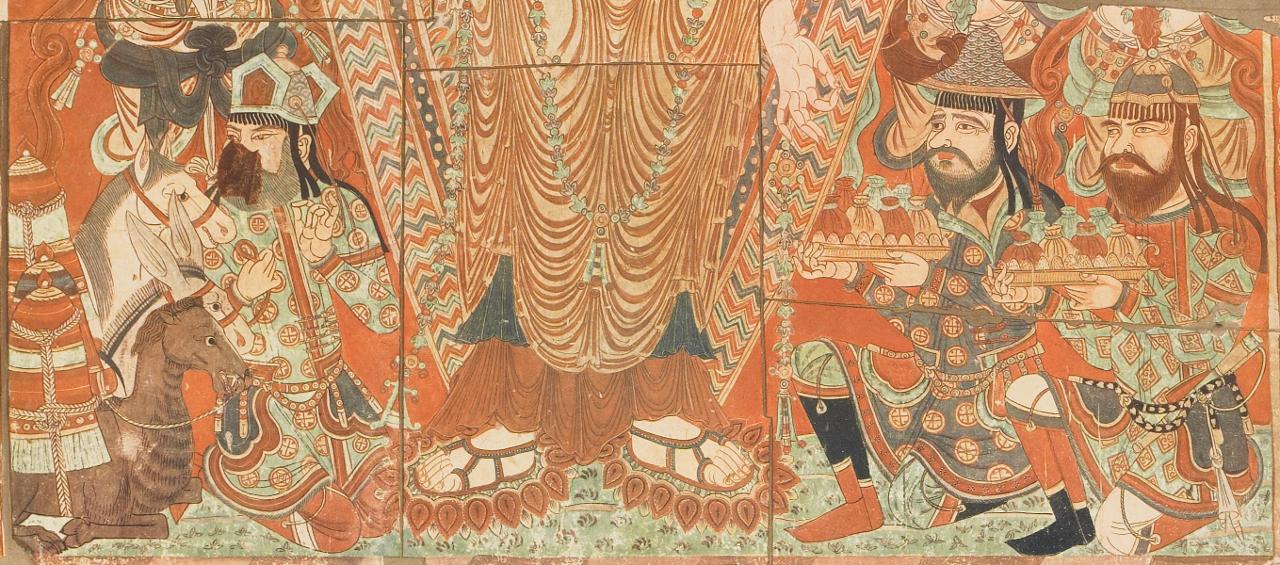
Shop Amazon - Create an Amazon Baby Registry
Praņidhi scene No. 6, Temple No. 9, Bšzšklik
Detail of Bezeklik (Bšzšklik) Fresco

An even larger detail of Bezeklik fresco, Pranidhi scene No. 6, Temple No. 9. Tarim Basin.


The two adorants in the lower right corner of the picture are shown in a kneeling position; in their hands they offer yellow (golden) bowls with a lower edge showing a chased leaf ornament. The offerings themselves consist of seven bulging bags (e.g. with gold dust) filled with different coloured bags and a number of them painted or dotted with a mesh pattern yellow or white cones of small size arranged around the bags on the tray; these cones may be the models of the Lamaist sacrificial pyramids (tib. g Dor-ma).
Most interesting is the man kneeling on the far right. The broad face, quite rough in expression, is framed by a thick red beard; a strong mustache hides the upper lip of the slightly open mouth, bushy, slightly curved brows extend above the bright green painted eyes. The front of the red hair is arranged in a row of narrow, ribbon-like strands that hang down to the browbones; hanging on the sides, in front of the ears, two wider strands of this kind down to the chest. The hair on the back of the head seems to fall in a smooth, heavy mass on the shoulder and back. The complexion is light with reddish brown tones. The head is covered by a hemispherical black cap with a gold braid and a gold top that carries a green gem on the apex; a double knotted cord hangs down from the cap; the front, visible part of this double cord is attached to the cap in a golden rosette. The clothing consists of a green, patterned, fur-trimmed tunic, which, closed in the middle, shows red, yellow-tinged cuffs on the chest and shoulders; above the hips there are black, red-edged, flap-like cuffs sewn with yellow braids, around which the belt, fastened with a buckle and decorated with heart-shaped silver ornaments, runs. There is a whip in the belt; a cloth hangs from it, tied on its string.
The trousers are white, the tops of the red and black boots are prevented from sliding down by a pair of cords that cross the thighs (see the secondary figure!) and are probably attached to the waistband.
His neighbour on the left also has a protruding nose, but his hair and eyes are black, the eyebrows droop and the beard is drawn out in two points.
The costume is on the whole similar to the one described, but it opens to the left, where it is turned up like a collar at the neck and shows lacing below the arm. Also different is the hat, which is black on the inside with a green border and on the outside a scale or wave pattern with golden-yellow bone decorated with a chain of heart ornaments.
The clothing of the adorant on the left is similar to that of the man just described; only the hat is of a different kind and seems to consist of a conical head part with opened forehead and neck protection. In his hand he holds the reins of the three beasts of burden on which he has made offerings. They are located in the cone-shaped, artfully tied balls on the back of the animals.
This personís face was damaged by a blow in the neck when we cleared the sand from the temple. The costumes of the other personalities, with the exception of those of the two clergymen, belong to mythology; the three kneeling adorants, on the other hand, probably wear the traditional costume in the country.
Source: Chotscho by Albert von Le Coq Plate 22
Referenced as figure 468 in The military technology of classical Islam by D Nicolle
468. Fresco from Bšzšklik, Semitic and Iranian merchents, 9th-10th centuries AD, east Turkistānī, Staatliche Museen Dahlem, West Berlin.
pp.206-7, A form of leg protection known as the sāq seems to have been used throughout the period under review in many parts of the eastern Islamic world, though perhaps remaining rare. Some, or perhaps all, were fastened to a belt by iron hooks.27 Although those referred to by al Ṭabarī were of mail,28, their shape may have corresponded to leggings which, drawn up over the wearer's knees and presumably fastened to a belt, feature in many illustrated sources from the east (Figs. 18, 126, 233, 237, 300, 307, 313, 331, 334, 341, 342, 356, 359, 365, 400, 422, 468, 477 and 623).
27. Al Ṭabarī, op. cit. vol. II, pp. 586-587.
28. Ibid.